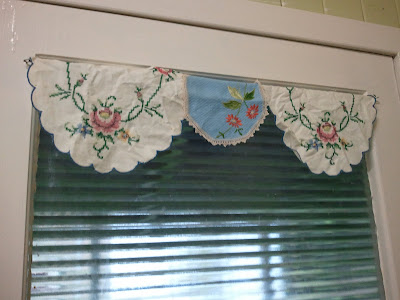Yesterday I briefly showed you photos of my pantry door that I did over.
Now the patchwork design is not my idea. Someone, somewhere on the web had posted photos of how they did the patchwork thingy using wallpaper scraps.
It was love at first sight.
(If you, genius person, happen to stumble over my humble blog and go, "That's my picture!" drop me a line so I can give you credit.)
Edit: I found who the creator was. It was done by Simone of Beach Vintage. There happened to be a photo of her standing in front of it in her latest post. Eureka! You'll see her in my favourite blogs roll down the side if you wanted to check out her site and see what more prettiness she has in store.
Edit: I found who the creator was. It was done by Simone of Beach Vintage. There happened to be a photo of her standing in front of it in her latest post. Eureka! You'll see her in my favourite blogs roll down the side if you wanted to check out her site and see what more prettiness she has in store.
Now they were a lot more adventurous with their colours. I am meanwhile trying to streamline my look and colour scheme in the (mistaken?) belief that it will make my house look less messy and jumblesome. While my walls are green at the moment, sometime in the future they will be turned pale blue so I chose a colour scheme that incorporates the two, rather successfully I think. I also tried to choose patterns that looked vintage and/or wallpaper-ish.
I also was not so adventurous in using wallpaper, as I've never hung wallpaper or even walked into a wallpaper shop in my life.
As the scrapbooking paper had worked quite well here
I thought I would go with it again.
The only difference was this time I used card instead of paper as it is less likely to get air bubbles.
Step 1.
Measure the place to be papered then decide how you want to divide it up.
I went with three across and three down for the top panel and four down for the bottom panel.
(The bottom rectangles are slightly longer than the top panel as it didn't divide neatly to the same measurements but you can't even notice.)
Step 2.
Lay your paper out roughly in a design that is balanced and pleasing to your eye.
Step 3.
Cut out your first rectangle to the dimensions you've chosen.
If you're not a straight cutter, I would recommend using a stanley knife and ruler as any gaps between patches will be noticable.
Step 4.
Using your rectangle as a template, trace around the other pieces of card and cut them out.
Step 5.
Glue the card down.
I used PVA glue thinned with water so it brushed on easier. I also spread the glue onto the panel rather than onto the paper as it gave a more pleasing result.
If your card isn't too damp, you can use a ruler to spread it down evenly, otherwise rub your hand firmly over the card to try to eliminate any air bubbles.
Step 6.
Leave it to air dry (which doesn't take long, I waited an hour) then paint with two coats of varnish, leaving drying time between, of course.
I use Cabot's Cabothane water-based varnish in Satin.
I like it because it cleans up in water, doesn't smell and doesn't yellow.
Step back and admire.
I did mine on panels which I then had to nail onto the pantry door frame. The beauty of this was that the frame covered up any messy edges.
I'm going to tackle the linen cupboard doors next which are already complete so I'll have to take more care with my edges, but this is such a simple project, it's really hard to mess up.
It turns something plain and utilitarian into a real focal point and work of art.
Let me know how you go if you try it.
















